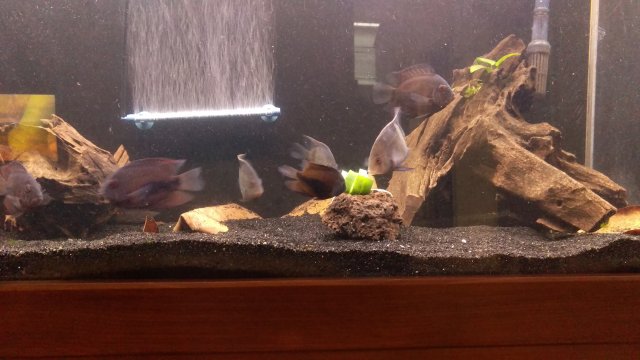A quick question on using ro water to anyone who knows. I have read that below a certain ph your beneficial bacteria die off leading to a nitrogen cycle crash. What is the lower limit of that happening? How low can my ph go before my bio filter dies?
Uaru F. Log
- Thread starter Beetlebug515
- Start date
You are using an out of date browser. It may not display this or other websites correctly.
You should upgrade or use an alternative browser.
You should upgrade or use an alternative browser.
- Status
- Not open for further replies.
Bump for an answer? The pandas are doing great at 2 weeks. Huge appetite, great personality, and healing some damaged fins very well. The 10 giant almond leaves I added to the tank made no difference to the color of the water or the ph so I'm going to be adding peat today. hopefully I can get the water a bit more acidic than the 7 it measured this morning.
Pull the leaves back out and boil them first, It will help them leech. I would be careful lowering ph, particularly if you have plants and/or high tds. I think you need a highly acidic environment before your biofilter doesn't help, like low 5s but don't quote me on that. Ammonium will be more prevalent at lower ph because the ammonia loses ions. Ammonium is not very dangerous, the biggest problems are when you maintain a low ph for a long time and the beneficial bacteria just doesn't have a food source, but then your ph rises and the ammonium converts back into ammonia and the bb can't deal with it because the colony is small.
Last edited:
No plants, and I'm using ro water so tds is very low. Actually a bit too low for my comfort right now. Going to add some extra tap water during today's water change.
No plants, and I'm using ro water so tds is very low. Actually a bit too low for my comfort right now. Going to add some extra tap water during today's water change.
I ended up editing my last post.
A few other random things. Why would you worry about low tds? These guys come from water with zero tds I thought. Have you had any aggression issues? I forgot to mention it but I've heard pandas are way meaner than the amphs. Peat will help, from what I gather the most important thing is redundancy. You've got water with no kh if on full ro, so ph can move a bit but you want low tds to avoid osmotic shock. I'm a hobbiest and by no means an expert on this, I've just put a lot of research into hopefully keeping these species one day. I hope you continue to have success with these, it will give me hope for the future.
My tds right now is 13ppm, less than one degree kh. I figure that if I am going to be tweaking ph at all, I want at least a little buffering capacity. 1-2 degrees kh would be ideal in my mind. Also, from what I have gathered, even soft water fish need some dissolved mineral content for the osmotic process. I don't want to deprive them of any micro nutrients they may need in their water.
As far as the aggression, the pandas are certainly more pushy than the amphs. I haven't seen any real aggression though. Most of the time the two species school together with problems happening only at feeding times. I haven't seen any tattered fins, eye clouding, hiding, or anything from the amphs that would suggest true aggression is going on. I think it is important to note that my amphs are about the same size as the pandas. I think if they were any smaller there might be a problem.
As far as the aggression, the pandas are certainly more pushy than the amphs. I haven't seen any real aggression though. Most of the time the two species school together with problems happening only at feeding times. I haven't seen any tattered fins, eye clouding, hiding, or anything from the amphs that would suggest true aggression is going on. I think it is important to note that my amphs are about the same size as the pandas. I think if they were any smaller there might be a problem.
From what I understand the TDS meters only measure conductivity and can't account for things like tannins, but admittedly I'm not sure what the ideal range for these guys would be. I've always assumed as low as possible is ideal but I've got more to learn. You are playing on the safe side and I think that is the proper course.
I think Charney
has some panda who ended up pairing up and killed conspecifics, I'd be worried that the amphs will not be excluded from any similar aggression.
Charney
has some panda who ended up pairing up and killed conspecifics, I'd be worried that the amphs will not be excluded from any similar aggression.
I think
- Status
- Not open for further replies.




